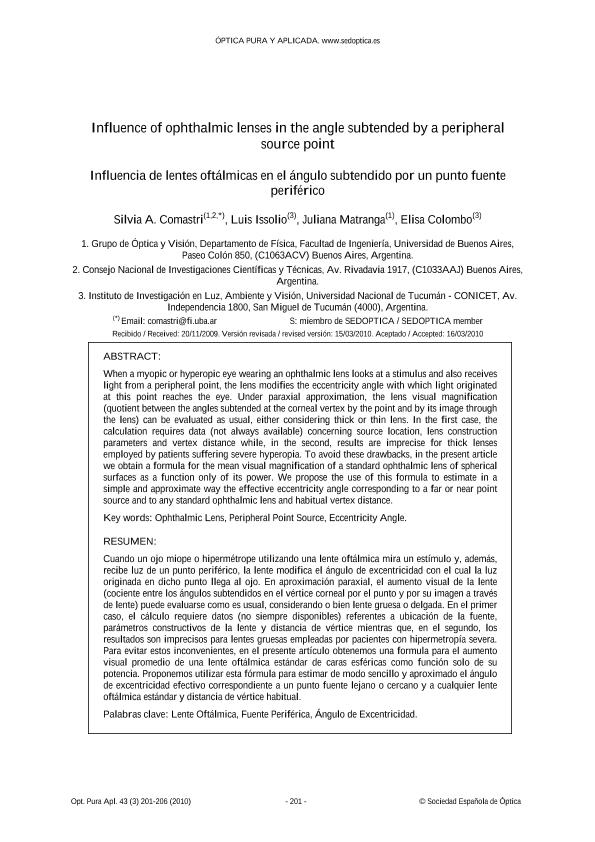Mostrar el registro sencillo del ítem
dc.contributor.author
Comastri, Silvia Ana Elva

dc.contributor.author
Issolio, Luis Alberto

dc.contributor.author
Matranga, Juliana

dc.contributor.author
Colombo, Elisa Margarita

dc.date.available
2019-09-12T17:15:10Z
dc.date.issued
2011-06
dc.identifier.citation
Comastri, Silvia Ana Elva; Issolio, Luis Alberto; Matranga, Juliana; Colombo, Elisa Margarita; Influence of ophthalmic lenses in the angle subtended by a peripheral source point; Sociedad Española de Óptica; Óptica Pura y Aplicada; 43; 3; 6-2011; 201-206
dc.identifier.issn
0030-3917
dc.identifier.uri
http://hdl.handle.net/11336/83430
dc.description.abstract
Cuando un ojo miope o hipermétrope utilizando una lente oftálmica mira un estímulo y, además, recibe luz de un punto periférico, la lente modifica el ángulo de excentricidad con el cual la luz originada en dicho punto llega al ojo. En aproximación paraxial, el aumento visual de la lente (cociente entre los ángulos subtendidos en el vértice corneal por el punto y por su imagen a través de lente) puede evaluarse como es usual, considerando o bien lente gruesa o delgada. En el primer caso, el cálculo requiere datos (no siempre disponibles) referentes a ubicación de la fuente, parámetros constructivos de la lente y distancia de vértice mientras que, en el segundo, los resultados son imprecisos para lentes gruesas empleadas por pacientes con hipermetropía severa. Para evitar estos inconvenientes, en el presente artículo obtenemos una formula para el aumento visual promedio de una lente oftálmica estándar de caras esféricas como función solo de su potencia. Proponemos utilizar esta fórmula para estimar de modo sencillo y aproximado el ángulo de excentricidad efectivo correspondiente a un punto fuente lejano o cercano y a cualquier lente oftálmica estándar y distancia de vértice habitual.
dc.description.abstract
When a myopic or hyperopic eye wearing an ophthalmic lens looks at a stimulus and also receiveslight from a peripheral point, the lens modifies the eccentricity angle with which light originated at this point reaches the eye. Under paraxial approximation, the lens visual magnification (quotient between the angles subtended at the corneal vertex by the point and by its image through the lens) can be evaluated as usual, either considering thick or thin lens. In the first case, the calculation requires data (not always available) concerning source location, lens construction parameters and vertex distance while, in the second, results are imprecise for thick lenses employed by patients suffering severe hyperopia. To avoid these drawbacks, in the present article we obtain a formula for the mean visual magnification of a standard ophthalmic lens of spherical surfaces as a function only of its power. We propose the use of this formula to estimate in a simple and approximate way the effective eccentricity angle corresponding to a far or near point source and to any standard ophthalmic lens and habitual vertex distance.
dc.format
application/pdf
dc.language.iso
spa
dc.publisher
Sociedad Española de Óptica
dc.rights
info:eu-repo/semantics/openAccess
dc.rights.uri
https://creativecommons.org/licenses/by-nc-sa/2.5/ar/
dc.subject
Ophthalmic Lens
dc.subject
Peripheral Point Source
dc.subject
Eccentricity Angle
dc.subject.classification
Óptica

dc.subject.classification
Ciencias Físicas

dc.subject.classification
CIENCIAS NATURALES Y EXACTAS

dc.title
Influence of ophthalmic lenses in the angle subtended by a peripheral source point
dc.title
Influencia de lentes oftálmicas en el ángulo subtendido por un punto fuente periférico
dc.type
info:eu-repo/semantics/article
dc.type
info:ar-repo/semantics/artículo
dc.type
info:eu-repo/semantics/publishedVersion
dc.date.updated
2019-06-04T15:57:10Z
dc.journal.volume
43
dc.journal.number
3
dc.journal.pagination
201-206
dc.journal.pais
España

dc.journal.ciudad
Elche
dc.description.fil
Fil: Comastri, Silvia Ana Elva. Consejo Nacional de Investigaciones Científicas y Técnicas; Argentina. Universidad de Buenos Aires. Facultad de Ingeniería. Departamento de Física; Argentina
dc.description.fil
Fil: Issolio, Luis Alberto. Consejo Nacional de Investigaciones Científicas y Técnicas. Centro Científico Tecnológico Conicet - Tucumán. Instituto de Investigación en Luz, Ambiente y Visión. Universidad Nacional de Tucumán. Facultad de Ciencias Exactas y Tecnología. Instituto de Investigación en Luz, Ambiente y Visión; Argentina
dc.description.fil
Fil: Matranga, Juliana. Universidad de Buenos Aires. Facultad de Ingeniería. Departamento de Física; Argentina
dc.description.fil
Fil: Colombo, Elisa Margarita. Consejo Nacional de Investigaciones Científicas y Técnicas. Centro Científico Tecnológico Conicet - Tucumán. Instituto de Investigación en Luz, Ambiente y Visión. Universidad Nacional de Tucumán. Facultad de Ciencias Exactas y Tecnología. Instituto de Investigación en Luz, Ambiente y Visión; Argentina
dc.journal.title
Óptica Pura y Aplicada
dc.relation.alternativeid
info:eu-repo/semantics/altIdentifier/url/http://sedoptica.es/Menu_Volumenes/Pdfs/OPA43-3-201.pdf
Archivos asociados
